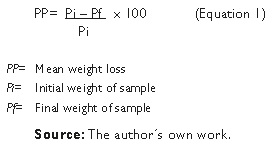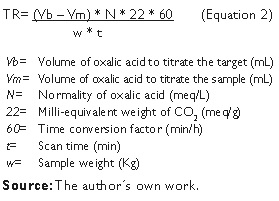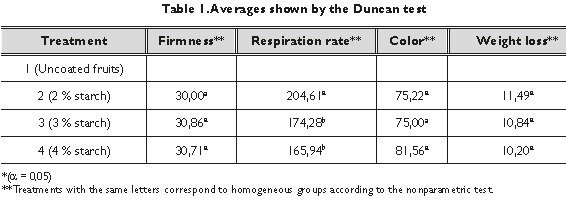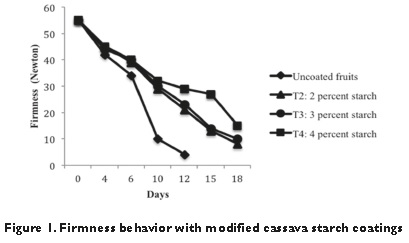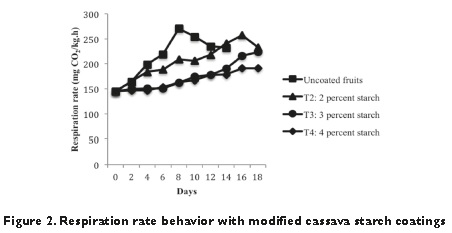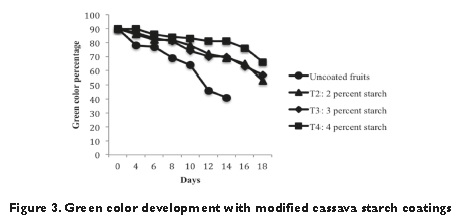Services on Demand
Journal
Article
Indicators
-
 Cited by SciELO
Cited by SciELO -
 Access statistics
Access statistics
Related links
-
 Cited by Google
Cited by Google -
 Similars in
SciELO
Similars in
SciELO -
 Similars in Google
Similars in Google
Share
Producción + Limpia
Print version ISSN 1909-0455
Rev. P+L vol.10 no.2 Caldas July/Dec. 2015
Coating Effect of Modified Cassava Starch in Hass Avocado*
Efecto de recubrimiento de almidón de yuca modificado sobre aguacate hass
Efeito do recobrimento da modificação da mandioca amido em Abacate Hass
Diana Alejandra Solís Jimenez**, Lady Nathaly Pineda Salazar***, Silvio Andrés Mosquera Sánchez****, José Luís Hoyos Concha*****, Héctor Samuel Villada Castillo******
* Article derivative undergraduate thesis entitled "Effect of coating application hydrolyzed cassava starch (Manihot sculenta Crantz) on the maturation of avocado (Persea americana Miller) Hass variety" culminated on March 1 2013 and funded by the Cauca University.
** Agroindustrial Engineering, Cauca University. Agroindustrial Engineering, Cauca University. Cauca, Colombia
*** Agroindustrial Engineering, Cauca University. Cauca, Colombia
**** Masters in Engineering. Cauca University Professor, Faculty of Agricultural Sciences, Popayán-Colombia.
***** Master in food science. Cauca University Professor, Faculty of Agricultural Sciences, Popayán-Colombia.
****** Doctor. Food Sciences. Cauca University Professor, Faculty of Agricultural Sciences, Popayán-Colombia
Autor correspondencia: Silvio Andrés Mosquera Sánchez, email: smosquera@unicauca.edu.co
Artículo recibido: 28/02/2015; Artículo aprobado: 11/12/2015
Abstract
Introduction. The production and commercialization of avocado are growing, but there are postharvest handling inconsistencies that lead to poor product quality. This situation must be corrected in order to ensure the proper conservation by using appropriate techniques, such as the use of environmentally friendly edible coatings. Objective. We evaluated the effect of modified cassava starch coatings (Manihot esculenta) on respiration rate, firmness, weight loss and color development of the Hass variety avocado (Persea americana Miller), at temperature of 24°C and relative humidity of 77,5 %. Materials and methods. A randomized complete block design with four treatments was used: T1: uncoated fruits; T2: 2 %; T3: 3 % and T4: 4 % starch, all with 2 % glycerin. Three replicates were performed and the results were subjected to analysis of variance (a=0,05). Results. Significant differences were found for respiration rate and color, with the 4 % starch coating being the most responsive to maintaining fruit quality conditions. Conclusions. Coatings with 2, 3 and 4 % starch retained quality characteristics as a result of lower weight and firmness loss, diminished respiration rate and color preservation.
Key words: ripening, edible coating, starch, postharvest.
Resumen
Introducción. La producción y comercialización de aguacate está creciendo pero su manejo pos cosecha presenta inconsistencias que conducen a la baja calidad de los productos. Esta situación debe ser corregida para garantizar su adecuada conservación mediante técnicas apropiadas como, por ejemplo, el uso de recubrimientos comestibles que son amigables con el ambiente. Objetivo. Se evaluó el efecto de un recubrimiento a base de almidón de yuca (Manihot esculenta) modificado sobre la tasa de respiración, firmeza, pérdida de peso y desarrollo del color de aguacate variedad Hass (Persea americana Miller), a temperatura de 24 oC y humedad relativa del 77,5 %. Materiales y métodos. Se aplicó un diseño de bloques completamente al azar con cuatro tratamientos y tres repeticiones, así: T1: frutos sin recubrimiento, T2: con 2 %, T3: 3 % y T4: 4 % de almidón, todos con 2 % de glicerina, sometiendo los resultados a un análisis de varianza (a=0,05). Resultados. Se encontraron diferencias significativas para las variables tasa de respiración y color, siendo el recubrimiento elaborado con 4 % de almidón el mejor para mantener las condiciones de calidad de la fruta. Conclusiones. Los recubrimientos con 2, 3, y 4 % de almidón mantuvieron las características de calidad como resultado de una menor pérdida de peso y de firmeza, disminución en la tasa de respiración así como también en la conservación del color verde.
Palabras clave: maduración, recubrimiento, almidón, poscosecha.
Resumo
Introdução. A produção e comercialização de abacate está crescendo mas seu manejo pós colheita apresenta inconsistências que conduzem à baixa qualidade dos produtos. Esta situação deve ser corregida para garantir sua adequada conservação mediante técnicas apropriadas como, por exemplo, o uso de recobrimentos comestíveis que são amigáveis com o ambiente. Objetivo. Se avaliou o efeito de um recobrimento a base de amido de mandioca (Manihot esculenta) modificado sobre a taxa de respiração, firmeza, perda de peso e desenvolvimento do color de abacate variedade Hass (Persea americana Miller), a temperatura de 24 oC e umidade relativa de 77,5 %. Materiais e métodos. Se aplicou um desenho de blocos completamente ao azar com quatro tratamentos e três repetições, assim: T1: frutos sem recobrimento, T2: com 2 %, T3: 3 % e T4: 4 % de amido, todos com 2 % de glicerina, sometendo os resultados a uma análise de variação (a=0,05). Resultados. Se encontraram diferencias significativas para as variáveis taxa de respiração e color, sendo o recobrimento elaborado com 4 % de amido o melhor para manter as condições de qualidade da fruta. Conclusões. Os recobrimentos com 2, 3, e 4 % de amido mantiveram as características de qualidade como resultado de uma menor perda de peso e de firmeza, diminuição na taxa de respiração assim como também na conservação da cor verde.
Palavras chave: maduração, recobrimento, amido, pós-colheita.
Introduction
Production and commercialization of avocado are on the rise globally, due to its cherished qualities and properties, including high levels of bioactive compounds like vitamin E, ascorbic acid, carotenoids and soluble phenolic compounds, as well as essential oil in large quantities, which is a flavor determining factor in a wide variety of fruits (Obenland et al., 2012). From the physiological point of view, avocado does not reach maturity for consumption on the tree. Therefore, time and harvest conditions are determinant for the fruit´s ripening and the fast senescence rate, which is reflected in color and size, although it is difficult to determine because of the invisible external changes that can occur at the beginning of the harvest.
The potential of starch as an edible coating material has been widely recognized because of its good mechanical strength, low permeability to water and because it acts as a barrier against gases, generating isotropic, odorless, tasteless, colorless, non-toxic and biologically degradable films (Prakash et al., 2013), also improving brightness and opacity, decreasing retrogression and increasing freeze/thaw cycle stability. Zamudio et al. (2007) used it in combination with oxidized plantain starch for the production of films, which were assessed for color.
Atmosphere modification during post-harvest conservation of fruit is important to reduce water loss (Quintão et al., 2012), respiration rate and senescence (Barco et al., 2011), besides providing other desirable effects like maintaining firmness and color by altering the gas composition that surrounds the fruit (Quintão et al. 2012). Lago et al. (2013), Barbosa et al. (2012) and Ojeda and Sgroppo (2009) evaluated the effect of cassava starch on the ripening of pumpkin, tomato, mango and papaya at room temperature and on the quality and shelf life of cucumber (Cucumiss ativus L.), finding a significant delay in ripening, weight loss, changes in skin color, firmness, soluble solids and titratable acidity.
Due to the growing demand for healthy food, increasingly stringent quality requirements and the need to preserve the fruit´s characteristics during storage, a project was formulated to develop a coating based on modified cassava starch and measure its effect on the ripening of Hass variety avocado under environmental conditions.
Materials and methods
Materials
Raw material. Top-quality avocados supplied by the Colombia International Corporation (CCI, for its acronym in Spanish) were used, picked from the "El Limon" farm located in El Tambo (Cauca, Colombia), a town located at 2°2715" latitude north and 76°4004" longitude west with a mean temperature of 24°C. Harvesting was performed after 36 weeks when the fruit reached physiological maturity by a loss of skin brightness.
Starch. Cassava starch (CM 7595-1 variety) modified enzymatically with Bacillus amyloliquefaciens a-amylase with a degree of modification of 10 % Dextrose Equivalent.
Methods
Fruit´s treatment. The avocados selected were washed with water at 20°C and submerged for 10 min in 2 % Tego 51 solution, for disinfection.
Preparation and application of the coating. Coatings were prepared by mixing the components, varying the amount of cassava starch and adding 2 % glycerin (Achipiz et al., 2013). The mixture was subjected to a water bath at temperatures between 65 and 70°C for 15 min and cooled at the ambient conditions of the city of Popayan, Colombia (17 °C and 77 % relative humidity). The avocados were coated by dipping, holding them by the stem for 30 seconds and then left to dry at room temperature.
Measurement of variables. For 18 days, every other day, 12 avocados per treatment were taken and the following variables were measured:
Mean weight loss. A RADWAG ® analytical scale, accurate at ± 0,05 mg, was used to determine variations in weight over time, by applying the following equation:
Respiration rate. A respirometer consisting of a CO2 trap with a breathing chamber and a Pettenkofer tube, captures the CO2 expelled by the fruit and expresses breathing intensity in mg CO2/kg/h (Barco et al., 2011):
Firmness. The process was standardized with the SHIMADZU EZ-L ® universal testing machine, by direct testing on the fruit in the equatorial area at a cell speed of 10 mm/min and 1 cm penetration depth.
Color. A stereoscope (Nikon SMZ 800 ®) was used, with a digital camera to measure color progress by taking three points on the equator of each fruit and processing the images in the MatLab software®, determining the percentage of green color.
Experimental Design
A completely randomized block design was used with 3 replicates per treatment. The experimental units were randomly assigned by varying the starch concentration (T1=fruit without coating; T2= 2 % starch; T3= 3 % starch and T4= 4 % starch) and the results were submitted to analysis of variance (a=0,05) and test of means through the Duncan method, using the SPSS 12.0 software.
Results and discussion
It is worth highlighting that the control sample was evaluated from day 1 to day 14, the time at which decomposition became evident. Therefore it was discarded, in order to avoid contamination of fruits from the other treatments.
Firmness
Firmness is an important indicator for determining the degree of ripening. Therefore, greater ripeness equals less firmness and less resistance to penetration. No significant differences were noted between treatments (table 1) and firmness decreased in all the treatments over time (figure 1). Uncoated fruits showed a 93 % loss of firmness with mean compression force of 29 N ,while in the coated fruit the loss was 62, 58 and 47 %, respectively, with force of 30, 31 and 35 N for treatments 2, 3 and 4.
Zapata et al. (2007) noted the influence of the zein coating on decreased degradation of cell wall compounds due to hydrolysis, which produces softening, as well as to the conversion of starch to sugars (Khurnpoon, Siriphanic and Labavitch, 2008). The results are similar to those obtained by Barbosa et al. (2012) in mango, Barco et al. (2011) in tomato and by Aguilar et al. (2008) in avocado, which asserts that loss of firmness is inversely proportional to starch concentration in the film covering the fruit.
Weight loss
No significant differences were noted between treatments (table 1) and increased weight loss resulting from respiration was observed. The treatment with 4 % cassava starch presented less weight loss than the other treatments with 20,87 % loss by day 18, while with 3 % starch it was 22,12 %; with 2 % starch, 23,67 % and the control sample lost 18,65 % up to day 14, time at which it was eliminated due to pollution. Figueroa et al. (2007) reported that the primary mechanism for moisture loss in fresh fruits and vegetables is the diffusion of water vapor due to a pressure gradient between the inside and the outside of the fruits, which was controlled by the coating on the fruit´s surface acting as a barrier and, thus, reducing moisture loss due to the transpiration process. Research by Barbosa et al. (2012), Quintão et al. (2012), Barco et al. (2011) and Aguilar et al. (2008) yielded similar results, which allows concluding that lower weight loss occurs at higher concentrations of starch suspension, being inversely proportional and obtaining better results at 4 percent concentration of modified starch in this work.
Respiration rate
Significant differences were noted between treatments and contrast between the treatment means was observed by obtaining two subsets, showing differences between T4 and T1 values (table 1).
The fruit from the control sample reached the climacteric peak on day 8. Subsequently, the senescence phase began where cells die and there is no O2 consumption to turn it into CO2. Those coated with 2 % reached the climacteric peak on day 16, while in those coated with 3 and 4 % the climacteric peak was not observed due to the coating action (figure 2). Respiration, as a fundamental physiological process in the breakdown and synthesis of metabolites in the fruit, requires oxygen as the main substrate, which is affected by the physical barrier exercised by the coatings, reducing the respiration rate with the corresponding shelf life extension, as found by Amaya et al. (2010) and Zapata et al. (2007) on tomato and Márquez, Cartagena and Pérez (2009) on Japanese loquat. It was concluded that the application of the coating decreased the respiration rate in coated fruits by decreasing CO2 production, with which a delay of the avocado ripening process was achieved.
Color
Fruits began with 90 percent green color, which was progressively lost until turning to black, due to the catalytic reduction of the chlorophyllase enzyme as the fruit ripened (figure 3). By day 14, the control sample retained 41 % of the green color, while by day 18 the green color rates were 53,60 and 66 % for fruit coated with 2, 3 and 4 % starch, respectively. No significant differences were observed (table 1), as in the case of Barbosa et al. (2012).
The color fluctuation from green to black, shown in the avocados, indicated the appropriate ripening or consumption level, which coincided with the climacteric peak reached on day 8 for uncoated fruit, while the fruit with 4 % starch did not undergo color change or reach climacteric peak, coinciding with the results reported by Park and Chinnan (2004) in tomato. This could possibly be due to the fact that the coating acts as a barrier against oxygen migration, thus preventing oxidation processes (Lago et al., 2013). During the avocado ripening process, progressive loss of color was evident and was markedly significant in the control sample while in the starch-coated fruit color was retained in varying proportions, with the best performance registered in the 4 % treatment.
Conclusions
Fruits coated with treatments at 2, 3 and 4% cassava starch had positive incidence on quality characteristics, resulting in less weight loss, decreased respiration rate, delayed loss of firmness and conservation of green color as compared to uncoated Hass avocados. The T4 treatment with 94 % water is the most effective one, concerning the variables evaluated, given the fact that it confers the necessary functionality and presentation facilitating and promoting marketing, benefiting producers with the generation of added value and offering highquality products to consumers.
Acknowledgments
The authors express their gratitude to Universidad del Cauca, for providing the human resources and facilities required to carry out the project.
Bibliographic references
Achipiz, S.; Castillo, A.; Mosquera, S.; Hoyos, J. & Navia, D. (2013). Efecto de recubrimiento a base de almidón sobre la maduración de la guayaba (Psidium guajaba). Revista Biotecnología en el sector agropecuario y agroindustrial, 2, 92-100. [ Links ]
Aguilar, M.; San Martín, E.; Tomás, S.; Cruz, A. & Jaime, M. (2008). Gelatine-starch films: Physicochemical properties and their application in extending the post-harvest shelf life of avocado (Persea americana). Journal of the Science of Food and Agriculture, 88(2), 185-193. [ Links ]
Amaya, P.; Peña, L.; Mosquera, S.; Villada, H. & Villada, D. (2010). Efecto de recubrimiento de almidón nativo de yuca sobre la firmeza y tasa de respiración del tomate (Solanum lycopersicom). Revista Dyna, 77(162), 67-73. [ Links ]
Barbosa de Lima, A.; Silvanda de Melo, S.; Rocha, A.; Cordeiro do Nascimento, L. & De Souza, F. (2012). Conservação pós-colheita de manga 'tommy atkins' orgânica sob recobrimentos bio-orgânicos. Revista Brasileira de Fruticultura Jaboticabal, 34(3), 704-710. [ Links ]
Barco, P.; Burbano, A.; Mosquera, S.; Villada, H. & Navia, D. (2011). Efecto del recubrimiento a base de almidón de yuca modificado sobre la maduración del tomate. Revista Lasallista de Investigación, 8(2), 97-98. [ Links ]
Figueroa, J.; Salcedo, J.; Olivero, R. & Narváez, G. (2011). Recubrimientos comestibles en la conservación del mango y aguacate, y perspectiva, al uso del propóleo en su formulación. Revista Colombiana de Ciencias Animales, 3(2), 386-400. [ Links ]
Khurnpoon, L.; Siriphanic, J. & Labavitch, J. (2008). Cell wall metabolism during fruit dehiscence. Postharvest Biology and Technology, 48, 391-401. [ Links ]
Lago-Vanzela, E.; Do Nascimento, P.; Fontes, E.; Mauro, M. & Kimura, M. (2013). Edible coatings from native and modified starches retain carotenoids in pumpkin during drying. LWT -Food Science and Technology, 50, 420-425. [ Links ]
Márquez, C.; Cartagena, R. & Pérez, B. (2009). Efecto de recubrimientos comestibles sobre la calidad en poscosecha del níspero japonés (Eriobotrya japónica T.). Revista Vitae, 16(3), 304-310. [ Links ]
Obenland, D.; Sue Collin, J.; Negm, F. & Arpaia, M. (2012). Influence of maturity and ripening on aroma volatiles and flavor in 'Hass' avocado. Postharvest Biology and Technology, 71, 41-50. [ Links ]
Ojeda, G. & Sgroppo, S. (2009). Aplicación de un film comestible en batatas trozadas. Corrientes: Universidad Nacional del Nordeste. Facultad de Ciencias Exactas Naturales y de Agrimensura. 2009. [ Links ]
Park, H. & Chinnan, M. (2004). Gas and water vapor barrier properties of edible films from protein and cellulosic materials. Journal of Food Engineering, 25, 497- 507. [ Links ]
Prakash, J.; Maran, V.; Sivakumar, R.; Sridhar, V. & Immanuel, P. (2013). Development of model for mechanical properties of tapioca starch based edible films. Industrial Crops and Products, 42, 159-168. [ Links ]
Quintão, S.; Oshiro, A. & Mugnol, D. (2012). Conservação pós-colheita de guavira (Campomanesia adamantium Camb.) sob diferentes revestimentos e temperaturas de armazenamento. Revista Brasileira de Fruticultura Jaboticabal, 34(4), 1022-1029. [ Links ]
Zamudio, P.; Bello, L.; Vargas, A.; Hernández, J., & Romero, C. (2007). Caracterización parcial de películas preparadas con almidón oxidado de plátano. Agrociencia, 41, 837-844. [ Links ]
Zapata, P.; Valero, D.; Guillén, F.; Martínez, D. & Serrano, M. (2007). Mantenimiento de la calidad de tomates mediante recubrimiento de zeína. Tecnología Poscosecha y Agro exportaciones, 9(9), 1384-1393. [ Links ]













